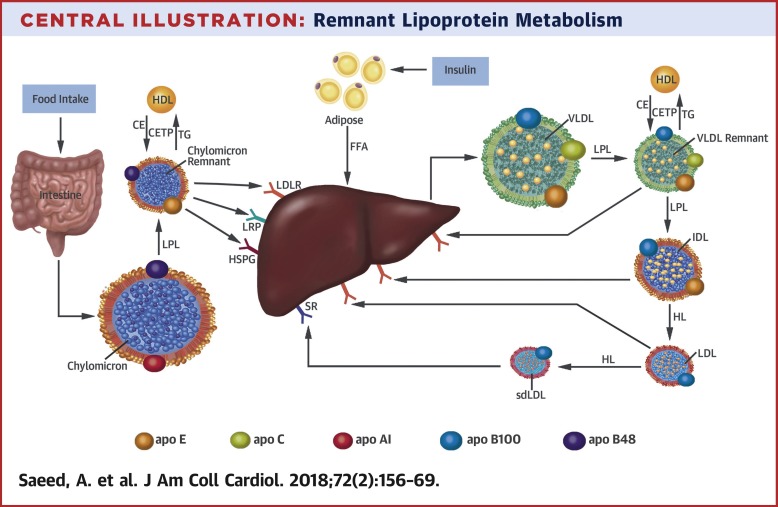当前位置:
X-MOL 学术
›
J. Am. Coll. Cardiol.
›
论文详情
Our official English website, www.x-mol.net, welcomes your
feedback! (Note: you will need to create a separate account there.)
Remnant-Like Particle Cholesterol, Low-Density Lipoprotein Triglycerides, and Incident Cardiovascular Disease
Journal of the American College of Cardiology ( IF 21.7 ) Pub Date : 2018-07-01 , DOI: 10.1016/j.jacc.2018.04.050 Anum Saeed 1 , Elena V Feofanova 2 , Bing Yu 2 , Wensheng Sun 1 , Salim S Virani 3 , Vijay Nambi 4 , Josef Coresh 5 , Cameron S Guild 6 , Eric Boerwinkle 2 , Christie M Ballantyne 7 , Ron C Hoogeveen 1
Journal of the American College of Cardiology ( IF 21.7 ) Pub Date : 2018-07-01 , DOI: 10.1016/j.jacc.2018.04.050 Anum Saeed 1 , Elena V Feofanova 2 , Bing Yu 2 , Wensheng Sun 1 , Salim S Virani 3 , Vijay Nambi 4 , Josef Coresh 5 , Cameron S Guild 6 , Eric Boerwinkle 2 , Christie M Ballantyne 7 , Ron C Hoogeveen 1
Affiliation

|
BACKGROUND
Hypertriglyceridemia is associated with increased remnant-like particle cholesterol (RLP-C) and triglycerides in low-density lipoprotein (LDL-TG). Recent studies have focused on atherogenicity of RLP-C, with few data on LDL-TG. OBJECTIVES
The aim of this study was to examine associations of RLP-C and LDL-TG with incident cardiovascular disease (CVD) events and genetic variants in the ARIC (Atherosclerosis Risk In Communities) study. METHODS
Fasting plasma RLP-C and LDL-TG levels were measured in 9,334 men and women without prevalent CVD. Participants were followed for incident CVD events (coronary heart disease and ischemic stroke) for up to 16 years. Associations between LDL-TG and RLP-C levels and genetic variants were assessed by whole-exome sequencing using single-variant analysis for common variants and gene-based burden tests for rare variants; both an unbiased and a candidate gene approach were explored. RESULTS
RLP-C and LDL-TG levels were correlated with triglyceride levels (r = 0.85 and r = 0.64, p < 0.0001). In minimally adjusted analyses, RLP-C and LDL-TG were associated with CVD risk, but in models adjusted for traditional risk factors including lipids, only LDL-TG was associated with incident CHD (hazard ratio: 1.28; 95% confidence interval: 1.10 to 1.50) and stroke (hazard ratio: 1.47; 95% confidence interval: 1.13 to 1.92). A common APOE variant, rs7412, had the strongest association with LDL-TG and RLP-C (p < 5 × 10-8). CONCLUSIONS
RLP-C and LDL-TG levels were predictive of CVD and associated with APOE variants. LDL-TG may represent a marker of dysfunctional remnant lipoprotein metabolism associated with increased CVD risk. Further research is needed to determine whether LDL-TG plays a causal role in CVD and may be a target for therapy.
中文翻译:

残留样颗粒胆固醇、低密度脂蛋白甘油三酯和心血管疾病事件
背景高甘油三酯血症与残余样颗粒胆固醇(RLP-C)和低密度脂蛋白(LDL-TG)中甘油三酯的增加有关。最近的研究主要集中在 RLP-C 的致动脉粥样硬化性上,而关于 LDL-TG 的数据很少。目的 本研究的目的是探讨 ARIC(社区动脉粥样硬化风险)研究中 RLP-C 和 LDL-TG 与心血管疾病 (CVD) 事件和遗传变异的关联。方法 对 9,334 名没有流行 CVD 的男性和女性进行空腹血浆 RLP-C 和 LDL-TG 水平测量。对参与者的 CVD 事件(冠心病和缺血性中风)进行长达 16 年的跟踪调查。通过全外显子组测序评估 LDL-TG 和 RLP-C 水平与遗传变异之间的关联,使用常见变异的单变异分析和罕见变异的基于基因的负荷测试;探索了无偏基因方法和候选基因方法。结果 RLP-C 和 LDL-TG 水平与甘油三酯水平相关(r = 0.85 和 r = 0.64,p < 0.0001)。在最小调整分析中,RLP-C 和 LDL-TG 与 CVD 风险相关,但在针对包括血脂在内的传统风险因素进行调整的模型中,只有 LDL-TG 与 CHD 发生相关(风险比:1.28;95% 置信区间:1.10)至 1.50)和中风(风险比:1.47;95% 置信区间:1.13 至 1.92)。常见的 APOE 变体 rs7412 与 LDL-TG 和 RLP-C 的关联性最强 (p < 5 × 10-8)。结论 RLP-C 和 LDL-TG 水平可预测 CVD 并与 APOE 变异相关。 LDL-TG 可能代表与 CVD 风险增加相关的残余脂蛋白代谢功能障碍的标志物。需要进一步的研究来确定 LDL-TG 是否在 CVD 中发挥因果作用,并可能成为治疗的目标。
更新日期:2018-07-01
中文翻译:

残留样颗粒胆固醇、低密度脂蛋白甘油三酯和心血管疾病事件
背景高甘油三酯血症与残余样颗粒胆固醇(RLP-C)和低密度脂蛋白(LDL-TG)中甘油三酯的增加有关。最近的研究主要集中在 RLP-C 的致动脉粥样硬化性上,而关于 LDL-TG 的数据很少。目的 本研究的目的是探讨 ARIC(社区动脉粥样硬化风险)研究中 RLP-C 和 LDL-TG 与心血管疾病 (CVD) 事件和遗传变异的关联。方法 对 9,334 名没有流行 CVD 的男性和女性进行空腹血浆 RLP-C 和 LDL-TG 水平测量。对参与者的 CVD 事件(冠心病和缺血性中风)进行长达 16 年的跟踪调查。通过全外显子组测序评估 LDL-TG 和 RLP-C 水平与遗传变异之间的关联,使用常见变异的单变异分析和罕见变异的基于基因的负荷测试;探索了无偏基因方法和候选基因方法。结果 RLP-C 和 LDL-TG 水平与甘油三酯水平相关(r = 0.85 和 r = 0.64,p < 0.0001)。在最小调整分析中,RLP-C 和 LDL-TG 与 CVD 风险相关,但在针对包括血脂在内的传统风险因素进行调整的模型中,只有 LDL-TG 与 CHD 发生相关(风险比:1.28;95% 置信区间:1.10)至 1.50)和中风(风险比:1.47;95% 置信区间:1.13 至 1.92)。常见的 APOE 变体 rs7412 与 LDL-TG 和 RLP-C 的关联性最强 (p < 5 × 10-8)。结论 RLP-C 和 LDL-TG 水平可预测 CVD 并与 APOE 变异相关。 LDL-TG 可能代表与 CVD 风险增加相关的残余脂蛋白代谢功能障碍的标志物。需要进一步的研究来确定 LDL-TG 是否在 CVD 中发挥因果作用,并可能成为治疗的目标。































 京公网安备 11010802027423号
京公网安备 11010802027423号